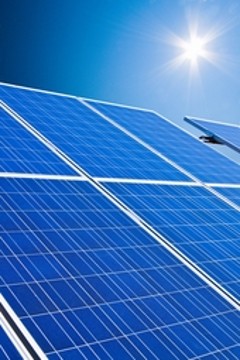Good organization at the planning stage assures safety

Source: © Gina Sanders - Fotolia.com
Germany is radically overhauling its energy policy. The national government's plans are for at least 35% of the country's energy to be generated from solar, wind and other sustainable energy sources by 2020. These sources currently account for 17% of the energy supply. Photovoltaic technology is an important element in the renewable energy mix. What issues must be considered during the installation of photovoltaic modules? Hans-Peter Steimel from the BG ETEM and Tim Pelzl from the DGUV answer questions on the subject.
Sunlight is an inexpensive source of energy. Property owners are increasingly choosing to fit photovoltaic modules on the roofs of their houses. Installation of the modules generally involves working at a height. What are the sources of hazards?
Steimel: Rotten beams, slippery roof edges – the important thing is for workers to be safeguarded during all roof work against the risk of falling off or through the roof. The roof should therefore be inspected for unstable parts before the work is performed. Insufficient awareness of the risks is, sadly, also reflected in the latest statistics for severe and fatal accidents; these reveal an alarming rise in 2011. Time and again, workers fall through roofs after walking on non-load-bearing roof coverings or assuming roof lights to be load-bearing.
The risk of falling must be considered on all roofs, irrespective of their type. On flat roofs (with a pitch of ≤ 20°), a risk of falling exists at all points less than two metres from the roof edge. On pitched roofs (with a pitch of > 20°), a risk of slipping and subsequently falling exists at all points. Protective equipment against falls from a height is required at all workplaces and routes to and from them at heights of two metres or more above the ground. This requirement will be familiar to any German electrical installation contractor from Section 12 (7) of the BGV C22 regulation governing construction work.
The employer responsible for the work must pay particular attention in order to ensure that the means of access to the roof is safe for use. Work platforms must therefore be fitted firmly and must be of adequate width; ladders must be stable, and must not be used to overcome height differences of more than five metres.
Electrical safety is also of crucial importance during installation of the modules. What aspects require attention?
Steimel: Photovoltaic installations for houses are generally preassembled. In other words, the roof area is measured and the modules custom-made for it. If the manufacturer's installation instructions are followed, the process is generally trouble-free. Improvisation is occasionally necessary, however. Should this result in current flowing through the body, i.e. an electric shock, it need not necessarily be fatal. However, it increases the risk of a secondary accident. Where installations require adaptation following purchase, a skilled electrician must be entrusted with the task. The same applies to extension of the domestic wiring. We sometimes encounter arrangements which contravene good electrical practice in every respect.
That must also have implications for fire safety.
Steimel: Certainly. The insurers of the premises therefore also require a report on the wiring.
But coming back to the subject of workplace hazards: a further source of hazards is generally found in the cellar. The inverter converts the direct current generated by the photovoltaic installation into the alternating current needed. This is where the greatest risk of electric shock exists during installation of the DC side of the system, since the cables often lie uninsulated on the floor, which may be damp. Should the fitter be holding a bare wire or an insufficiently insulated tool and then step in a puddle, he completes the circuit and receives an electric shock. At a total voltage of 500-800 V or even higher (the maximum permissible touch voltage is 120 V DC), a risk of a fatal electric shock exists. It is therefore advisable to dry out the workplace at the inverter and if appropriate to insulate it, for example by means of suitable insulating mats. Good preparation pays off at all these stages of the work, and is the cardinal rule of occupational safety.
Incidentally: what is the situation concerning the occupational safety of firemen who must extinguish the photovoltaic system in the event of a house fire?
Pelzl: The greatest risk facing the fire service personnel is that of falling parts. The mountings of the modules may fail when exposed to heat. It is therefore important that the site of the fire be suitably guarded.
The task of extinguishing the fire itself is not dangerous provided the principles and rules for firefighting on electrical installations are followed.* These require for example that during extinguishing, a working clearance of at least one metre must be observed from parts which may be live.
A photovoltaic system is almost always connected to the public power grid. Should such a system catch fire, skilled personnel should therefore be consulted, as with fires on other electrical installations. A hazardous DC voltage may however be present even when the system has been disconnected from the public grid. This DC voltage cannot be de-energized, since the "source", i.e. sunlight, cannot be switched off. Damage to DC cables also presents a risk of arcing. Depending upon its location, it may be possible to extinguish an arc only by disconnection.
_______________________
*Based upon BGI/GUV-I 8677 governing electrical hazards at fires, the code of practice governing firefighting on photovoltaic installations, and DIN VDE 0132 governing firefighting and emergency assistance at electrical installations.
Further general standards: VDE 0100-712 Low-voltage electrical installations - Part 7-712: Requirements for special installations or locations - Photovoltaic (PV) power systems
A suitable image for the article can be found at http://commons.wikimedia.org/wiki/File:Photovoltaik-Anlage_auf_Hausdach.jpg ()
More interviews on the following topics
